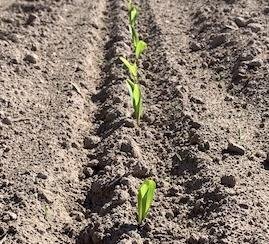Plant then Scout Now and Later
May 14, 2025

Very soon after planting it’s time to walk your fields and start scouting for emergence and potential issues, including weeds, disease, and insects.
Early on, it’s about stand and emergence. Craig Loen, ag sales rep at Federated Osceola, said, “When checking stand counts, be sure to be looking for the first plants to emerge.” He urged growers to “take notes and use a flag to mark the first plants.”
The goal is even emergence, with all the plants emerging 24-36 hours after the first few plants are out of the ground. Marking the first plants allows you to assess the stand better.
Loen said to also “check for singulation, double drops, skips. Look for planter variations in depth of seed, later emerging plants may have been placed too shallow.” Again, be sure to take notes of these observations.
Then, it’s all about the weeds. You won’t know what herbicides you need if you don’t know what weeds are in your fields. Of course, pre-emerge herbicides (see related article) are critical for the toughest weeds, but knowing what’s growing alongside your crop – and stealing its nutrients – will help you “determine the chemistry that will knock out the weeds that are most problematic on your farm,” he said.
Look for early season disease and insects as you scout fields when the crop is young. Potential threats to yield are best dealt with early on.
Talk to your Federated Agronomist to determine weed, insect, and disease treatments – sooner than later. Your agronomists are available to walk fields with you, too.
Early on, it’s about stand and emergence. Craig Loen, ag sales rep at Federated Osceola, said, “When checking stand counts, be sure to be looking for the first plants to emerge.” He urged growers to “take notes and use a flag to mark the first plants.”
The goal is even emergence, with all the plants emerging 24-36 hours after the first few plants are out of the ground. Marking the first plants allows you to assess the stand better.
Loen said to also “check for singulation, double drops, skips. Look for planter variations in depth of seed, later emerging plants may have been placed too shallow.” Again, be sure to take notes of these observations.
Then, it’s all about the weeds. You won’t know what herbicides you need if you don’t know what weeds are in your fields. Of course, pre-emerge herbicides (see related article) are critical for the toughest weeds, but knowing what’s growing alongside your crop – and stealing its nutrients – will help you “determine the chemistry that will knock out the weeds that are most problematic on your farm,” he said.
Look for early season disease and insects as you scout fields when the crop is young. Potential threats to yield are best dealt with early on.
Talk to your Federated Agronomist to determine weed, insect, and disease treatments – sooner than later. Your agronomists are available to walk fields with you, too.